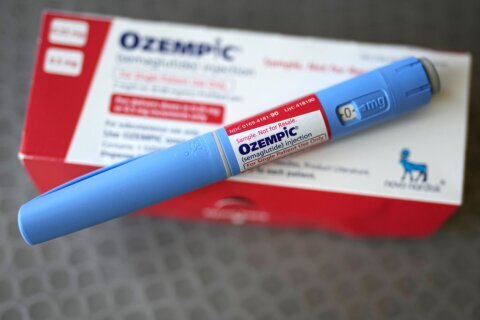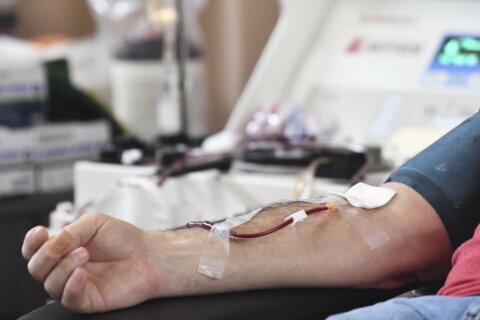Editor’s Note July 26, 2019, 1 p.m.: Environment America said Thursday that questions have been raised about the accuracy of its data used in this story. “Since we released the beaches report, some of our data has been called into question. To ensure the utmost accuracy, we are revisiting all the data and we will make our findings public as soon as possible.” It has also pulled down the original study. WTOP is reaching out to Environment America about the statement and will update this story as information becomes available. WTOP has removed the graph and interactive map associated with the data from this story.
To quote “Jaws”: Get out of the water! Also, ewww.
More than half of 4,523 beach sites tested in a new environmental study — including beaches that are local favorites in Virginia, Maryland and Delaware — were potentially unsafe for swimming on at least one day in 2018.
And 610 of those sites were potentially unsafe at least 25% of the days that sampling took place, according to Environment America.
The organization analyzed bacteria from beaches in 29 coastal and Great Lakes states, as well as Puerto Rico.
For the study, Environment America deemed beaches “potentially unsafe” if the bacteria levels exceeded the Environmental Protection Agency’s most protective “Beach Action Value” threshold — meaning what the EPA believes will cause 32 of 1,000 people to get sick from the water.
One real kick in the pants from the study: the fecal contamination.
“Human contact with the contaminated water, indicated by bacteria testing, can result in gastrointestinal illness as well as respiratory disease, ear and eye infections, and skin rash,” Environment America wrote.
“Each year in the U.S., swimmers suffer from an estimated 57 million cases of recreational waterborne illness.”
Urban runoff, sewage leaks and overflows, and industrial-scale livestock operations are key contributors of fecal matter in waterways, the organization said.
Here’s what Environment America’s data show, by states with beaches within reach from the D.C. area (the District was not sampled):
Delaware
Of 23 sites sampled in 2018, 7 (30%) were potentially unsafe for at least one day.
Top five, from most to least potentially unsafe days:
- Slaughter Beach (Sussex County) logged 16 potentially unsafe days over the course of 25 sampling days, making 64% of those days potentially unsafe.
- Fenwick Island State Park Beach (Sussex County) had three potentially unsafe days over the course of 16 sampling days, making 19% of those days potentially unsafe.
- Rehoboth Beach (Sussex County) fared well, with only three potentially unsafe days over the course of 31 sampling days, making 9% of those days potentially unsafe.
- Broadkill Beach (Sussex County) had two potentially unsafe days over the course of 16, making 12% of those days potentially unsafe.
- Lewes Beach North (Sussex County) had two potentially unsafe days over the course of 17, making 12% of those days potentially unsafe.
Maryland
Of 158 sites sampled in 2018, 79 (50%) were potentially unsafe for at least one day.
Top five, from most to least potentially unsafe days:
- Camp Pecometh (Kent County) had nine potentially unsafe days over the course of 16 sampling days, making 56% of those days potentially unsafe.
- Public Landing Beach (Worcester County) had eight potentially unsafe days over the course of 15 sampling days, making 53% of those days potentially unsafe.
- Ocean City Beach (Worcester County) had eight potentially unsafe days over the course of 28 sampling days, making 29% of those days potentially unsafe.
- Purse State Park (Charles County) had seven potentially unsafe days over the course of 12 sampling days, making 58% of those days potentially unsafe.
- Ferry Park (Kent County) had seven potentially unsafe days over the course of 10 sampling days, making 70% of those days potentially unsafe.
The good news is that Sandy Point’s east and middle beaches in Anne Arundel County had zero potentially unsafe days over the course of 15 sampling days. Sandy Point’s south beach had one potentially unsafe day out of 15, for 7%.
Chapman State Park, in Charles County, had zero potentially unsafe days over the course of four sampling days.
Point Lookout State Park, in St. Mary’s County, had two potentially unsafe days out of 15 sampling days, for 13%.
Virginia
Of 37 sites sampled in 2018, 19 (51%) were potentially unsafe for at least one day.
Top five, from most to least potentially unsafe days:
- North Community Beach (Norfolk) had seven potentially unsafe days over the course of 18 sampling days, making 39% of those days potentially unsafe.
- Captains Quarters (Norfolk) had five potentially unsafe days over the course of 18 sampling days, making 28% of those days potentially unsafe.
- 10th View, Behind Quality Inn, 1010 W Ocean View Ave. (Norfolk) had four potentially unsafe days over the course of 18 sampling days, making 22% of those days potentially unsafe.
- 15th Street (Virginia Beach) had four potentially unsafe days over the course of 20 sampling days, making 20% of those days potentially unsafe.
- 13th View, North End (Norfolk) had three potentially unsafe days over the course of 18 sampling days, making 17% of those days potentially unsafe.
There were two sample sites for Assateague in Accomack County, both right next to each other. The northern beach had zero potentially unsafe days out of 15, while the southern beach had one out of 15, for 7%.
And Sandbridge’s north and south beaches in Virginia Beach had zero potentially unsafe days out of 19.
Environment America recommended “drastically” increasing funding to fix sewage systems, preventing runoff through natural/green means, protecting natural infrastructure and strengthening the enforcement of water treatment standards.
The organization also suggested temporarily prohibiting new or expanded industrial-scale livestock operations, as well as using the EPA’s most protective “Beach Action Value” bacteria standard for making beach advisory decisions.








